When a special occasion calls for sharp style, many gentlemen find themselves standing at a wardrobe crossroads: what’s the difference between a tux and a suit, and which one should you wear? In this guide, we’ll walk through the key differences in design, fabric, accessories and formality, so you’ll know exactly when to reach for a tuxedo and when a well-cut suit will do the job just right.
1. What is a tuxedo?
What is a tuxedo, exactly? A tuxedo, often simply called a tux, is a type of suit that is designed for black-tie affairs and the most elegant occasions. In a simple term, a tuxedo is a two or three-piece ensemble that stands apart from a regular suit through a few refined and unmistakable details.
One of the most defining features of a tuxedo is the use of satin. You’ll typically find satin on the lapels of the jacket, along the stripe running down the side of the trousers, and often on the buttons. This subtle sheen adds a level of sophistication that’s unique to formal evening wear.
The lapels design are usually peaked or shawl-style, both considered more formal than the notched lapels commonly seen on suits.

2. What is a suit?
If the tuxedo is the king of formalwear, then the suit is its versatile and dependable cousin, appropriate for everything, from business meetings to weddings and nearly every occasion in between. At its core, a suit is typically consisting of a jacket and matching trousers, both should be made from the same fabric and designed to be worn together.
Unlike tuxedos, suits do not feature satin accents. The suit lapel, buttons and its trouser seams are usually made from the same material as the rest, giving suits a more understated and adaptable appearance. This subtle difference is often the first clue in the conversation of suit vs tux.
Suits come in a wide range of styles, fabric choice, colors and cuts, allowing gentlemen to express their personality and adapt to the dress code of the event.

3. What’s the difference between a tux and a suit
While tuxedos and suits may appear similar at a glance, the differences lie in the details. And those details matters. Let’s walk through the main differences in this tuxedo vs suit comparison, by every elements that matter the most.
Fabric & trim
One of the most defining contrasts is in the fabric finish. Tuxedos almost always feature satin trim on the lapels, the buttons and the stripe down the leg of the trousers. Like what I’ve said earlier, this sheen adds formality and a touch of evening elegance.
Suits, on the other hand, are made from the same fabric throughout, typically in wool, cotton, or linen, with no satin accents. This makes suits more understated and suitable for a broader range of occasions.
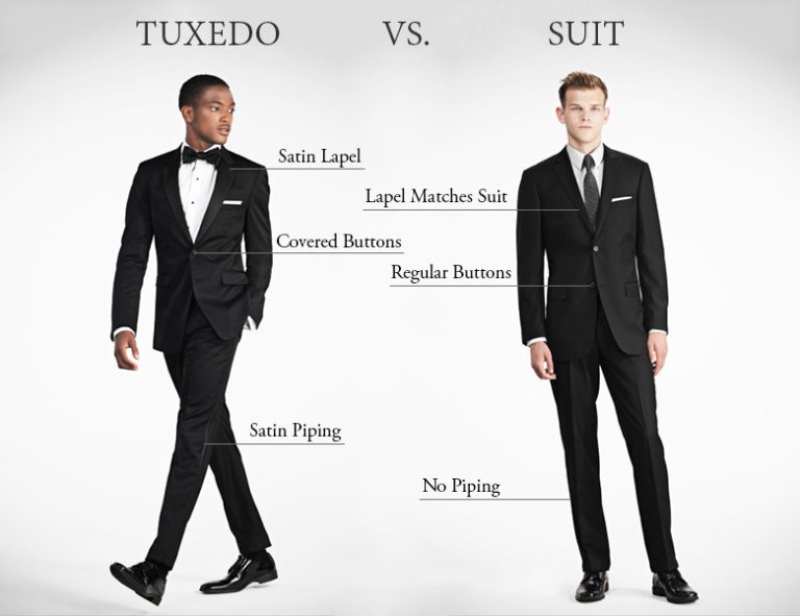
Shirts & accessories
Tuxedos are traditionally paired with a formal white dress shirt, often pleated or with a piqué bib and worn with a black bow tie. Accessories such as a cummerbund or waistcoat, black patent leather shoes, and sometimes even shirt studs complete the polished look.
Suits offer more freedom. They can be worn with a button-down shirt in various colors and patterns, paired with a tie or left open-collared for a modern, relaxed feel. When it comes to footwear, leather Oxfords, derbies or even loafers can work, depending on where you want to attend. This flexibility is why many grooms and guests ask about the difference between tux and suit for wedding—the answer depends on the tone of the event.
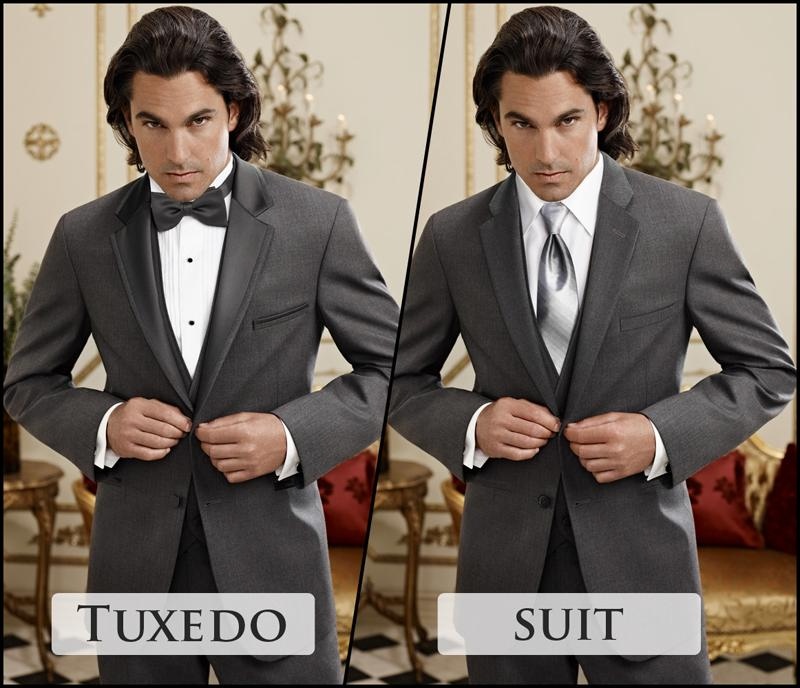
Buttons & lapels
Tuxedo jackets typically come with one button and feature peak or shawl lapels finished in satin. These lapel styles are considered more formal. Suit jackets, on the other hand, often have two or three buttons and notch lapels, which are simpler and more casual in appearance.
Some suits may also feature peak lapels, especially in more fashion-forward or double-breasted style, but without the satin finish, they still fall below tuxedos on the formality scale.
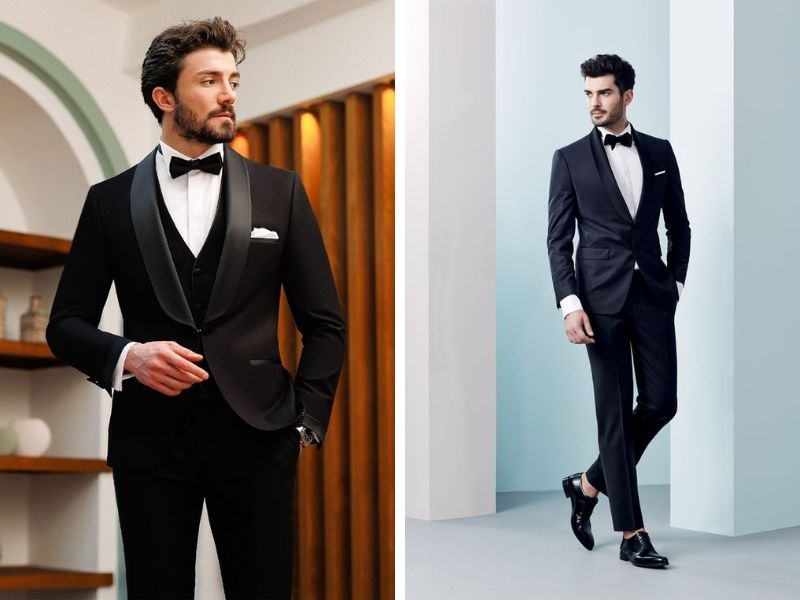
Formality & occasion
This is where the real difference comes into play. Tuxedos are reserved for formal evening events like black-tie weddings, galas, balls and award ceremonies.
When the dress code says black tie, a tux is your only proper choice. Suits, meanwhile, can be worn for daytime or evening occasions, both formal and semi-formal. They’re appropriate for business settings, less formal weddings, cocktail parties and even funerals.

4. When should you wear a tuxedo vs a suit?
Weddings
If you’re wondering about the classic tux vs suit wedding debate, it all comes down to the dress code and time of day. For an evening wedding with a black-tie dress code, a tuxedo is the clear winner. It communicates elegance and tradition, make it a perfect choice for the groom, groomsmen or a guest at a formal ceremony.
On the other hand, daytime or semi-formal weddings often call for a suit. A well-fitted navy, charcoal or even light grey suit offers polish without being too formal. If you’re the groom and want something serious but can be flexible at the same time, a three-piece suit with a vest can strike that perfect balance.
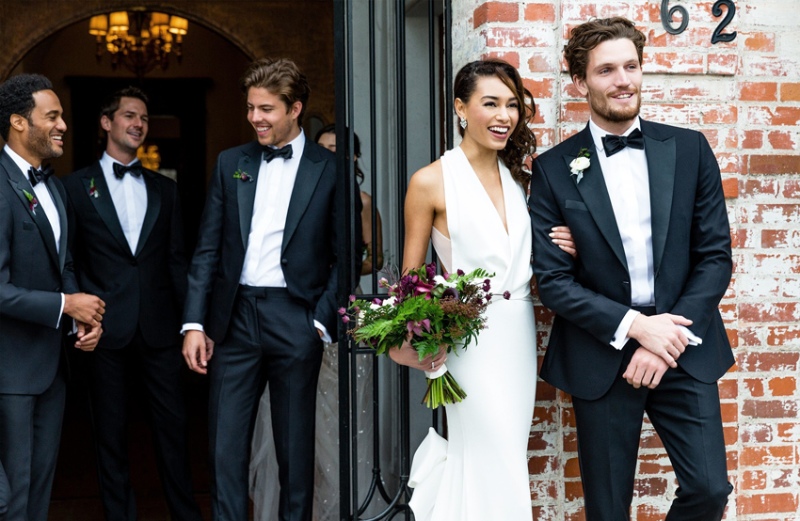
Black-tie events
This is when there’s no room for improvisation, you’ll want to wear a tuxedo. This includes charity galas, award nights, formal banquets and opera evenings. A tuxedo is built for these moments, with its satin details and classic accessories like the bow tie or cummerbund.
If you’re unsure when to wear a tuxedo, just remember: if the setting is formal and after 6 PM, and the invitation specifies or implies elegance, the tux is your best companion.
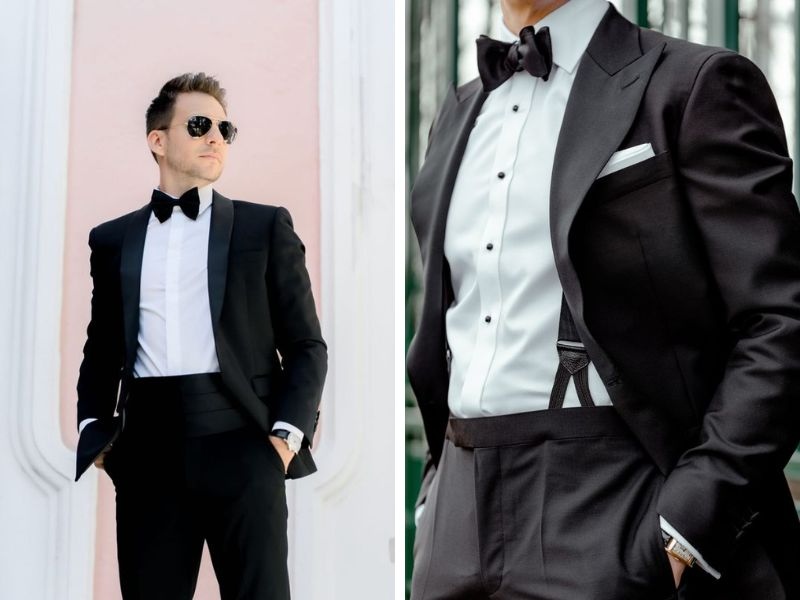
Work and business functions
This is where the suit truly shines. Boardroom meetings, client presentations, conferences or business dinners are all situations that call for a sharp and well tailored suit. Tuxedos are far too formal and out of place in the business world. If you’re wondering when to wear a suit, the answer is: almost always, when the goal is to look professional, polished and put-together.
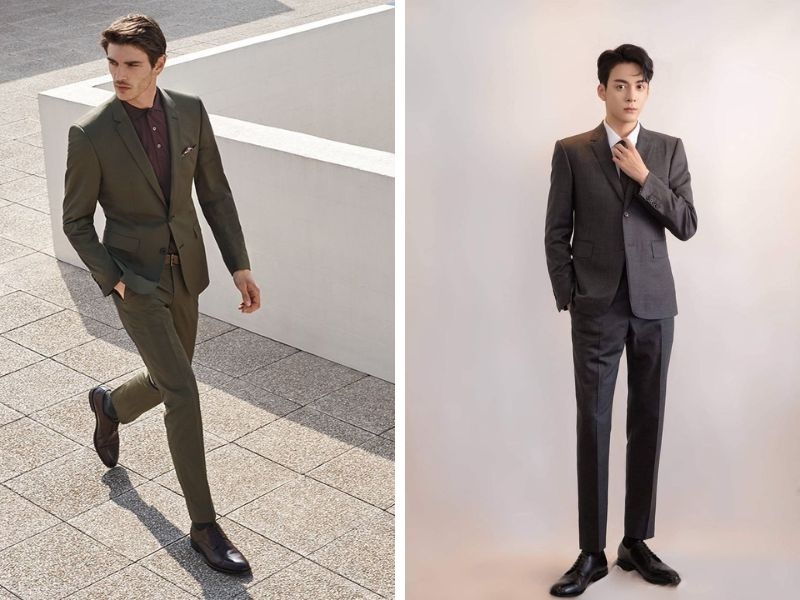
Formal dinners and celebrations
For semi-formal dinners, cocktail parties or milestone celebrations like anniversaries or graduation ceremonies, suits are often the most appropriate choice. They give you a clean, refined appearance without the rigidity of black-tie dress codes. You can also personalize your suit with a tie that fits the mood, or else you can go tieless for a more relaxed vibe.
5. Can you wear a suit instead of a tux?
It depends. While suits offer flexibility and ease, choosing one over a tuxedo in the wrong setting can lead to unintentional styling mistake.
If you’re attending a black-tie event, a suit is generally not appropriate. The “black tie” designation is not just a suggestion. It’s a formal dress code, and showing up in a suit can make you stand out for the wrong reasons. The room will be filled with satin lapels and bow ties, and even the sharpest suit may look underdressed by comparison.
In these cases, wearing a suit instead of a tux can make you be alienated from others and come across as careless or uninformed.
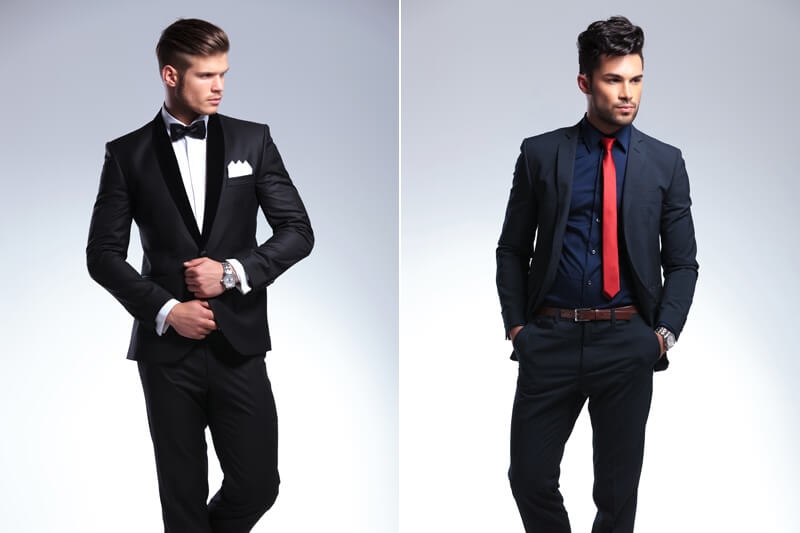
That said, if the event is described as “black tie optional” or formal, you may have some room to be creative. But be careful, if you decide to go with a suit instead of a tux, it needs to be elevated. Stick to darker colors like black, deep navy or charcoal. Go with a crisp white dress shirt and a refined silk tie or even a black bow tie for a tuxedo-inspired twist. Polish it off with black leather Oxfords or patent shoes. This way, your suit channels the elegance of a tux without breaking the dress code.
Another helpful dress code tip: focus on the details. A well-fitted suit with a formal pocket square, cufflinks and clean lines can bridge the gap between semi-formal and formal. But remember: no matter how nice the suit is, if the event specifically have a dresscode that call for a tux, it’s best not to be inapproriate.
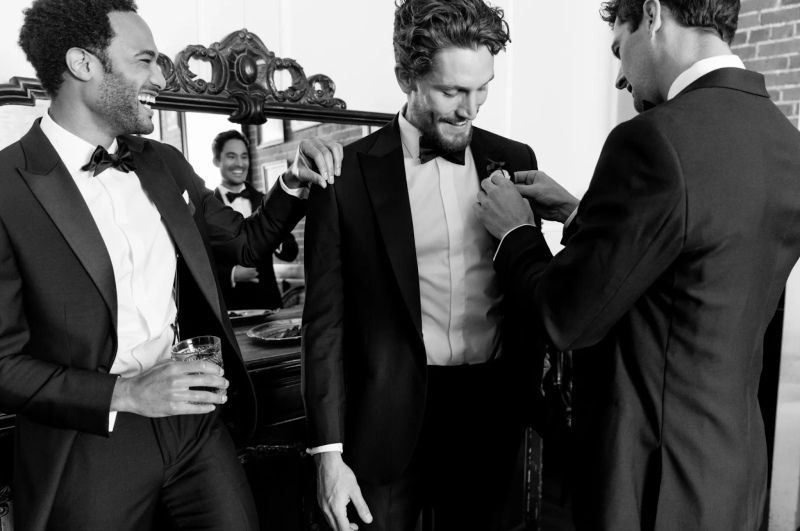
At the end of the day, knowing what’s the difference between a tux and a suit gives you the confidence to choose the right attire for every occasion. A tuxedo brings timeless elegance to the most formal events, while a classic suit offers versatility and refinement for everything from business meetings to cocktail parties. Whether you’re stepping out in a sleek tux or a sharply tailored suit, the right choice always starts with understanding the difference and wearing it with confidence.
Image source: Internet
Create from my passion about sartorial that I accidently discover when I was searching to upgrade my style, this website is dedicated to providing in-depth knowledge, expert styling tips and the latest trends in men’s tailored fashion. Though sometimes I might sound a little cheesy cuz of all that philosophy book I’ve read 🙂
